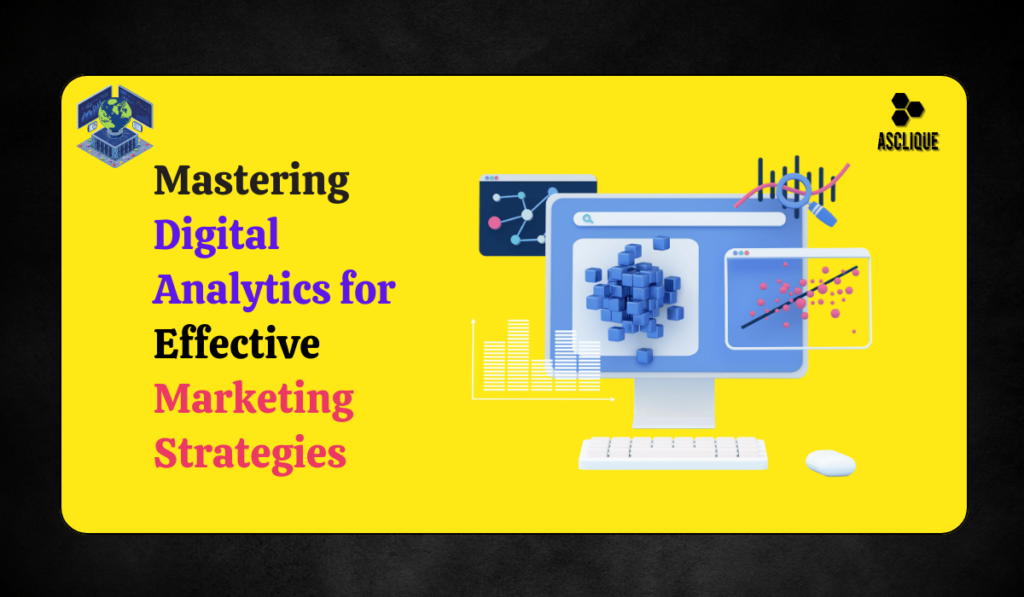As marketing grows in the world of the Internet, it may be more an art than science. Understanding the audience, tracking, and making performance-based changes based on that result is at the center of a really effective marketing approach. Welcome digital analytics—a leading tool for extracting raw data from information, ensuring businesses can be guided in appropriate decision-making through optimal marketing planning.
This blog will explain the role of digital analytics in marketing, tools, and metrics used, and how businesses can utilize analytics to gain success.
What is Digital Analytics in Marketing?
Digital analytics refers to the gathering, analysis, and interpretation of data from various digital platforms. These data disclose the ways by which users are interacting with websites, social media channels, email campaigns, and any other online platform. For marketers, digital analytics forms the cornerstone for creating targeted campaigns, understanding customer behavior, and optimizing investments in marketing.
Key Tools for Digital Analytics
The digital analytics world is broad, with tools designed for different purposes. Here are some of the mostly used tools:
Google Analytics
- Free and robust platform to track website traffic, user behavior, and conversions. It provides audience demographics, interests, and geographic locations.
Adobe Analytics
- Premium tool that offers advanced analytics features such as real-time data processing and predictive analytics.
HubSpot Analytics
SEMrush and Ahrefs
- These tools are essential for SEO analytics and help track keyword performance, backlinks, and competitors’ strategies.
Social Media Analytics Tools
- Meta Insights, Twitter Analytics, and LinkedIn Analytics are some of the platforms that give detailed performance data on posts, engagement, and audience behavior.
Through these tools, marketers can get the complete picture of their campaign and audience.
Benefits of Digital Analytics in Marketing Campaigns
Combining digital analytics with marketing campaigns produces a number of benefits:
Superior Customer Knowledge
- Analytics shows your audience what attracts them, perhaps a certain category of content or product or service. This ensures that the same marketing strategies tailored to your targeted audience are offered.
Maximize Campaign Performance
- Digital analytics can now determine which medium and campaign works, thus helping enterprises to invest intelligently.
Highest ROI
- Through data-driven choice, wasteful spending is saved by investing efforts in those programs that deliver an ROI.
Real-Time Tracking and Flexibility
- Analytics tools provide real-time data, which allows marketers to adjust campaigns rapidly according to performance trends.
Core Metrics to Track in Digital Analytics
The right metrics are critical to deriving value from digital analytics. Some of the key metrics include:
Website Metrics
- Sessions: The total visits to your site, including repeated visits.
- Bounce Rate: The proportion of visitors who leave your site after viewing just a single page.
- Average Session Duration: Shows how engaged users are with your content.
Conversion Metrics
- Lead Generation: Users filling in forms or signing up for newsletters.
- Sales Conversions: How many sales were generated through direct purchases on your campaigns?
Social Media Metrics
- Engagement Rate: Users interacting with your content.
- Reach and Impressions: People seeing your posts and how often.
Campaign-Specific Metrics
- Click-through rate (CTR): What percent of clicks your ad gets.
- Cost per acquisition – the cost paid to acquire a customer.
- Return on investment (ROI): It determines the profitability of your campaigns.
Why is digital analytics key to marketing growth?
More than just a tool, digital analytics is really a strategic asset no business can afford to ignore. That’s why it’s a matter of importance for marketing-driven growth.
Understanding customer behavior
Analyzing data like page views, bounce rates, and conversions helps businesses understand how customers interact with their digital touchpoints. This provides insight to tailor campaigns based on customer needs.
Optimization of Marketing Spend
Analytics has the effect of highlighting which channels and campaigns are contributing the highest ROI to businesses. They can then strategically invest resources in those areas that bring about growth.
Optimizing Campaign Performance
Real-time tracking of data enables marketers to track campaigns and make necessary adjustments. Whether it is tweaking the creative of an ad or adjusting targeting parameters, analytics ensures that the campaigns are always on track and on target.
Driving Personalization
Modern marketing lies at the heart of personalization. Analytics gives data required to segment the audience and then deliver the customized content that makes them more interactive and brings a better conversion rate.
Future Forecasting
Predictive analytics anticipates future behaviors based on historic data. The marketer, using this approach, can always anticipate trends and proactively strategize.
How Digital Analytics Can Benefit Marketing
A systematic approach towards digital analytics would help businesses exploit its full potential in marketing:
Understand Your Target Audience
A/B Testing
- Test different versions of ads, landing pages, or email campaigns in order to know which one is best.
Customer Journey Tracking
- Monitor the interactions of your users with your brand across different channels, from awareness to conversion. It will help identify bottlenecks and opportunities for improvement.
User Experience Improvement
- Analytics points out areas where users drop off or experience friction, allowing you to improve your website and campaign designs.
Predictive Analytics: Forecast Trends
- Advanced tools can analyze historical data to predict future behaviors and trends, keeping you ahead of the competition.
Challenges in Digital Analytics
Digital analytics has its challenges despite the many benefits:
Data Privacy and Compliance
- Compliance with regulations like GDPR or CCPA is critical to maintain trust and avoid legal issues.
Interpretation of Big Data
- The sheer volume of data can overwhelm marketers. Investment in user-friendly tools and training is crucial.
Integration with Existing Systems
- Analytics tools should be integrated into your marketing stack, which can be complex but crucial for accuracy.
Future Trends in Digital Analytics for Marketing
Digital analytics is not a static domain. It continues to evolve with several emerging trends that are expected to shape its future:
AI and Machine Learning
- These technologies will allow deeper insights through the identification of patterns and automating predictive analytics.
Focus on First-Party Data
- Third-party cookies are going out, so businesses will depend more on first-party data from the customers.
Cookieless Tracking
- Google Analytics 4 and others are setting up the future for privacy-first tracking methods.
Integration of IoT Analytics
- As IoT devices grow, integration into marketing analytics will create new possibilities.
Conclusion
Digital analytics is not a choice but a part of good marketing. Marketers, through knowledge and use of analytics, can enjoy a competitive edge, improve operations, and therefore achieve their marketing goals.
With changing technology, the new tools and trends that emerge make your marketing strategy better informed and effective. Start your digital analytics journey today and unlock the potential of your marketing efforts.
FAQs
What is the purpose of digital analytics in marketing?
Digital analytics helps marketers understand user behavior, measure campaign performance, and make data-driven decisions to optimize marketing strategies.
How does digital analytics improve ROI?
It points out the most performing channels and campaigns, enabling businesses to effectively allocate resources on strategies that give the best returns.
What are the most common tools for digital analytics?
Some of the most common tools include Google Analytics for website data, social media insights tools like Meta Insights, and CRM-integrated platforms like HubSpot Analytics.
What are the metrics that I should track for marketing success?
Key metrics include traffic (sessions, unique visitors), engagement (bounce rate, time on page), and conversions (leads, sales, ROI).
Is digital analytics suitable for small businesses?
Yes, digital analytics is affordable and scalable, boosting small business growth

